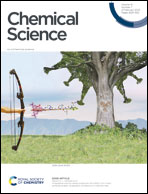Self-recovery of chiral microphase separation in an achiral diblock copolymer system†
Abstract
Macroscopic regulation of chiral supramolecular nanostructures in liquid-crystalline block copolymers is of great significance in photonics and nanotechnology. Although fabricating helical phase structures via chiral doping and microphase separation has been widely reported, the chiral memory and self-recovery capacity of asymmetric phase structures are the major challenge and still deeply rely on the presence of chiral additives. Herein, we demonstrate the first controllable chiral microphase separation in an achiral amphiphilic block copolymer consisting of poly(ethylene oxide) and azobenzene (Azo) groups. Chirality can be transferred to the fabricated helical nanostructures by doping with chiral additives (tartaric acid, TA). After the removal of the chiral additives and then performing cross-linking, the formed helical nanostructures will completely dispense with the chiral source. The supramolecular chirality and the micron-scale phase structure can be maintained under UV irradiation and heating-cooling treatment, enabling a reversible “on–off” chiroptical switch feature. This work is expected to avoid the tedious synthesis and expensive raw materials and shows a great application prospect in chiral separation and so on.

- This article is part of the themed collections: Celebrating the 110th Anniversary of chemistry at Soochow University and 2023 Chemical Science Covers


 Please wait while we load your content...
Please wait while we load your content...